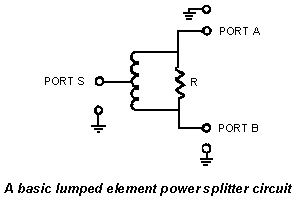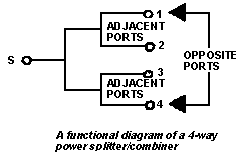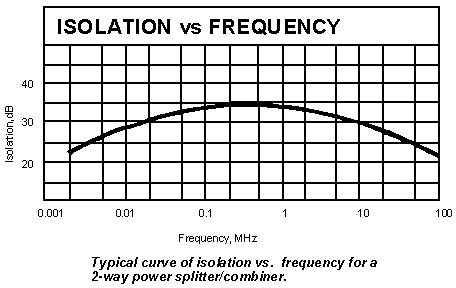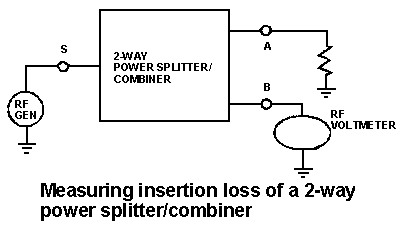Most Often Asked Questions About Power Splitter / Combiners
Q. What do the terms "internal load dissipation" and "matched power rating" mean?
A.
The internal load dissipation refers to the power rating of the internal terminations within the
power divider.

This level is given because improperly matched terminations on the output ports can result in reflected signals that could exceed the power limits of the internal terminations.
The matched power rating is usually several times higher than the internal load dissipation.
Q. Can performance parameters be traded off when specifying power splitter/combiners?
A. Once frequency range has been designated, there is not too much leeway in tradeoffs between the various spec parameters. Usually all the performance parameters of a well designed power splitter simultaneously fall off as a function of frequency. However, near the band edge, isolation may be improved at the expense of VSWR by adjusting the value of the internal load resistor Zo.
Q. What factors influence the power rating of a power splitter/combiner?
A.
Q. Suppose my application requires a power rating higher than a popular, low-cost "off-the-shelf" model. What can I do to keep costs down?
A. If an application demands an internal resistor power rating larger than available as a standard catalog item, it is possible to request from Mini-Circuits a unit with a higher rating internal resistor or a unit without an internal resistor. Then a higher power rating resistor can be out boarded; of course, the performance of the final combination will depend on the external resistor's characteristics, the way it is wired, and its capacitance to the board on which it is mounted. In most applications this should not be a problem.
Q. High isolation between output ports is critical in my application; insertion loss is not. Can I specify a power splitter design that trades one spec off for another?
A. The key performance parameters of a power splitter are usually influenced in the same direction during the design stage. A well-designed power splitter will offer high isolation, low insertion loss and good VSWR. You don't design a power splitter for high isolation and poor VSWR, nor for high isolation with a poor insertion loss. However, the design of the power splitter can, by reducing the bandwidth of the power splitter, be optimized on this narrower frequency range and improved isolation characteristics can be obtained to satisfy your application.
Q. I want to combine the output of two amplifiers. What parameter is most critical to spec?
A. Insertion loss is the critical spec since it will reduce the maximum power output that can be obtained. Isolation may not be a serious consideration
Q. Is intermodulation distortion critical in a power splitter/combiner?
A.
Q. I am making a two-tone, third-order IM measurement and the 2-way power combiner arrangement I am using does not provide adequate isolation for the low-level readings I am taking. What can I do?
A. Use a four-way splitter/combiner instead of a two-way. A general characteristic of a four-way
combiner is 20 dB or more higher isolation between opposite ports than adjacent ports.
Therefore, terminate ports 2 and 3 and apply inputs to ports 1 and 4 to obtain up to 40 dB
isolation.

Q. What effect will a slight mismatch at sum port have on power splitter/combiner isolation
performance?
A.
Now let's consider a slight mismatch at port S. Assume a + 20 dBm signal is applied to port A.
Since there is a 3 dB loss between ports A and S, the incident power at port S is +17dBm,
ignoring any slight transformer loss. If a slight impedance mismatch exists at port S, which
causes a 20 dB signal reflection, then a signal of 3 dBm (+17 dBm attenuated by 20 dB) is
sent back to ports A and B. This 3 dBm signal experiences a 3 dB loss as it is fed to port B,
and the mismatch at port S has now resulted in a 6 dBm signal at port B. Now the measured
isolation between ports A and B is not infinite; there is a + 20 dBm signal at port A and a 6
dBm signal at port B, for an isolation of 26 dB. In this case, one might incorrectly conclude the
splitter has an isolation of 26 dB when in fact it is infinite.

Q. I have been doing digital design work until last month when I was assigned to an RF
project. My boss told me to test the isolation of a power splitter and to make sure port S was
properly terminated. What does he mean "properly terminated?"
A.
If you used a 55-ohm termination, VSWR would be 1.1 (55/50) for a return loss of 26 dB. Let's see how this affects an isolation measurement. Assume a 0 dBm input from the RF generator at port A. First, the signal experiences a 3 dB loss traveling from port A through the power splitter and thus there is -3 dBm signal at port S. Now, due to the 1.1 VSWR, a 26dB reflected signal (or -29dBm) leaves port S, experiences another 3 dB loss through the splitter and arrives at port B at a level of -32 dBm. Thus, the 55-ohm termination contributed 26 dB loss to the inherent 6 dB loss of a two-way splitter.
Now, assume a "more perfect" termination of 51 ohms was used. Now VSWR is 1.02 (51/50) which produces a return loss of 39 dB, an improvement of 13 dB over the 55-ohm termination.
Just how hard should you strive for a "perfect" match? Use this rule of thumb. The return loss of the termination at S should be at least equal to the highest isolation you intend to measure; and remember, a 2-way coupler has an inherent 6 dB loss. Thus, if you wish to check a power splitter with a 30 dB isolation spec, the termination return loss should be at least 30 dB, requiring a termination VSWR of 1.06 or better. If you are concerned with a 20 dB isolation spec, a VSWR of 1.2 would be acceptable.
Q. Will mismatch at either port A or B of a 2-way power splitter/combiner cause significant
performance degradation?
A.
Let's take it one step further and assume port S and port A are properly terminated but port B is shorted. In a basic "T," a short across one input would obviously short everything.
In a practical power splitter/combiner, if port A and port S are properly terminated, but port B is shorted, there will be a 2 dB or so loss at port A. This is because the signal fed to port B will be reflected back to port S. If the termination at S is not perfect then a reflected signal will appear at port A, adding to the original signal level at A, thus slightly reducing the loss between port A and port S.
Q. I need to accurately check the insertion loss spec of a two-way power splitter. How can I do
it?
A.
A more accurate measurement involves the use of a calibrated 3 dB attenuator inserted between
test points A and S, with the power splitter removed from the test setup. The output level of the
RF generator is set so the RF voltmeter reading is near the top of the scale, its most accurate
region. Then, the 3 dB attenuator is removed and the power splitter is connected to test points A,
B and S. The difference between the first RF voltmeter reading and the new reading at point A
indicates the additional insertion loss over the theoretical 3 dB value. Thus, the insertion loss of
the power splitter under test is 3 dB plus the incremental reading. Repeat the procedure for port
B.

Q. I am using a 2-way power splitter in a military system and must calculate the reliability of the splitter. What is its MTBF?
A. Mini-Circuits 2-way splitters consist of two toroidal transformers, one ceramic NPO capacitor, and a hi-rel resistor exceeding MIL-R-10509. The ceramic capacitor reliability will be the determining factor in the reliability of the unit. Therefore, considering your application, refer to MIL Handbook 217 to make your calculation.
Q. What is a two-way, 180° power splitter?
A. A 180° power splitter provides two signals at its output - the signals are 180° out-of-phase with each other. Generally, one of the signals will be in phase with the input.
Q. How can I tell if a 2-way power splitter/ combiner is operating properly?
A.